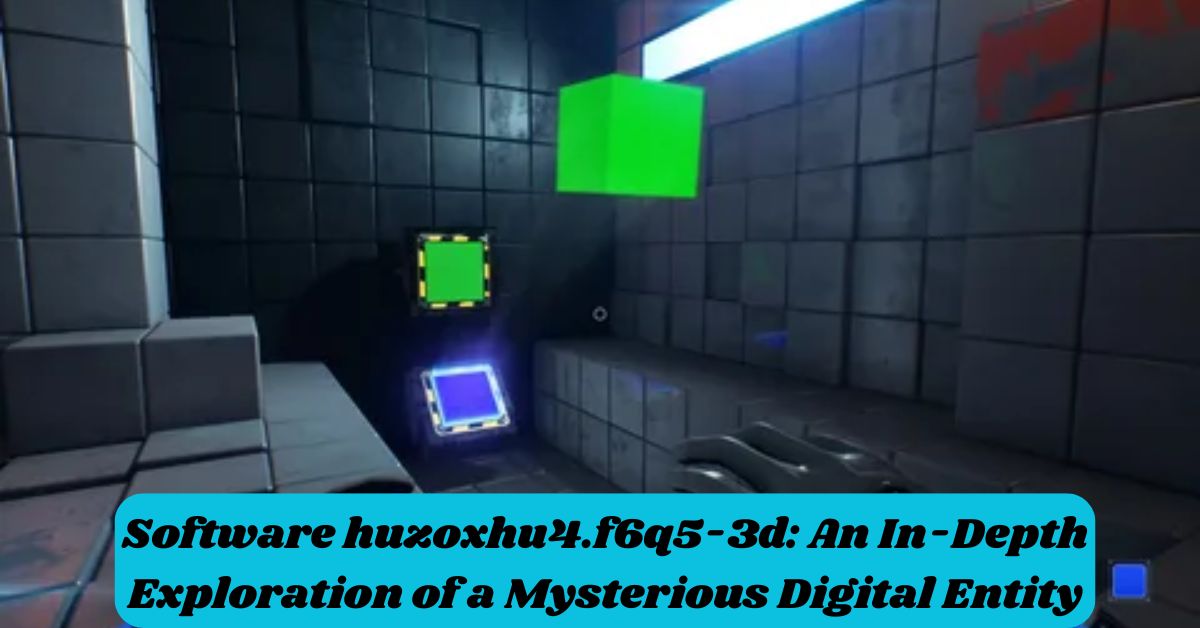In today’s rapidly evolving tech landscape, some tools remain hidden in plain sight. The mysterious entity known as software huzoxhu4.f6q5-3d has sparked curiosity among developers and security experts alike.
Despite its unusual name and limited documentation, this tool has found its way into specialized discussions across tech forums. This article explores what we know about this enigmatic software, its potential applications, and why it matters in modern software development ecosystems.
The Name: What is “huzoxhu4.f6q5-3d”?
The name itself presents our first mystery. Unlike conventional software names that aim for memorability, huzoxhu4.f6q5-3d follows a pattern more commonly seen in machine-generated identifiers. The mix of letters and numbers resembles a cryptographic hash or an internally assigned development code. Many experts suggest this naming convention points to software not originally intended for public use.
The structure contains what appears to be alphanumeric combinations typical of automated naming systems used in secure environments. This unusual identifier suggests the software may have originated as an internal tool before finding wider, if still limited, usage among specialized developers.
Origins and Theories
The true origins of huzoxhu4.f6q5-3d remain unclear, but several compelling theories exist. Some believe it emerged from a now-defunct cybersecurity startup based in Eastern Europe. Others point to evidence suggesting it’s a component from a larger security framework that was separated and repurposed. The lack of clear attribution isn’t unusual in certain corners of software development where tools evolve organically through community contributions.
The most credible theory connects the software to internal development projects within specialized security firms. The naming structure aligns with protected digital artifacts used in sensitive projects. The arbitrary-seeming identifier serves as a form of basic data obfuscation, making it harder to track or target. If true, this explains why conventional marketing materials or extensive documentation don’t exist for this tool.
Some security researchers have noted similarities between huzoxhu4.f6q5-3d and various developer tools designed for network penetration testing. The software’s limited footprint and specialized functions match the profile of utilities deployed in controlled security assessments rather than commercial products intended for wide distribution.
Functional Characteristics of Software huzoxhu4.f6q5-3d
From what specialists have gathered, huzoxhu4.f6q5-3d isn’t a single-purpose application but rather a multi-faceted toolkit. Its core functionality appears to revolve around several key capabilities that make it valuable in specialized environments.
Command-Line Interface Utility
True to its apparent technical roots, huzoxhu4.f6q5-3d operates primarily through a command-line interface. This design choice aligns with the Unix philosophy of creating tools that do specific tasks efficiently.
Users interact with the software through text commands rather than graphical interfaces. This approach allows for easier integration into automated scripts and workflows. The software reportedly accepts numerous parameters that modify its behavior, similar to other command-line utilities familiar to experienced system administrators.
The CLI operations supported include file analysis, metadata extraction, and various transformation functions. These operations can be chained together to create more complex workflows. Many users report the command syntax follows established patterns, making it accessible to those familiar with standard Unix-style command structures.
Configuration-Based Execution
Beyond simple command line options, huzoxhu4.f6q5-3d appears to support detailed operation through configuration files. These files allow users to define complex processing rules without crafting lengthy command strings. The software reportedly reads these configuration files at runtime, adjusting its behavior accordingly. This approach provides flexibility while maintaining consistency across multiple executions.
The configuration format appears to be YAML or JSON-based, allowing for human-readable yet machine-parsable instructions. This design choice supports both manual editing and automated generation of configurations. Such flexibility proves valuable in environments where processing needs change frequently based on input data or security conditions.
Cross-Platform Functionality
One notable feature frequently mentioned is the software’s cross-platform functionality. Unlike tools restricted to specific operating systems, huzoxhu4.f6q5-3d reportedly runs on Linux, macOS, and various Windows versions with minimal adaptation needed. This versatility suggests intentional design decisions to maximize compatibility across different computing environments.
The cross-platform nature hints at implementation in a language like Python, Go, or Rust, modern languages favored for portable security and system administration tools. This characteristic particularly benefits teams working in heterogeneous computing environments where standardizing on a single operating system isn’t practical.
Possible Networking Capabilities

Perhaps most intriguing are the reported networking capabilities of huzoxhu4.f6q5-3d. Multiple sources suggest the software includes functions for network analysis, port scanning, and traffic monitoring.
These features would be particularly valuable in security assessment scenarios. The networking functions reportedly work in passive modes that minimize detection risk a crucial consideration for security testing.
Some users have noted encrypted communication options that enhance privacy during sensitive operations. This functionality would align with tools designed for security professionals who must maintain confidentiality while conducting assessments or monitoring systems for potential vulnerabilities.
Use Cases in Modern Systems
Despite its obscurity, huzoxhu4.f6q5-3d has found applications across several specialized domains. Its utility stems from combining specific functions needed in technical environments without the overhead of larger, more generalized solutions.
DevOps Pipelines
In modern DevOps pipelines, efficiency and automation are paramount. Here, huzoxhu4.f6q5-3d reportedly serves as a specialized component for artifact verification and system validation.
Its speed and minimal resource requirements make it suitable for integration into continuous deployment workflows. The software’s ability to perform quick integrity checks aligns perfectly with the needs of fast-moving development environments.
Teams have reportedly integrated the tool into platforms like Jenkins, GitHub Actions, and GitLab CI to perform pre-deployment security validations. This integration helps catch potential issues before code reaches production environments. The focus on automation and deployment automation makes such lightweight tools invaluable in modern software delivery practices.
Security Testing Environments
Perhaps the most natural fit for huzoxhu4.f6q5-3d lies in security testing environments. Here, its reported capabilities align with needs for thorough yet efficient system analysis. Security professionals value tools that can identify potential vulnerabilities without disrupting production operations. The software’s apparent focus on minimizing system impact while providing detailed information fits this requirement perfectly.
Security researchers have mentioned using the software during controlled assessments to identify network configuration issues and potential data exposure risks. Its ability to operate with minimal footprint reduces the chance of triggering security alerts during legitimate testing activities. This stealthy operation particularly benefits organizations conducting internal security assessments.
Data Processing Pipelines
In specialized data processing environments, huzoxhu4.f6q5-3d reportedly serves as a preprocessing tool. Its transformation capabilities help prepare data for analysis while maintaining integrity and security. The efficiency of command-line operation makes it suitable for handling large volumes of information without excessive resource consumption.
Organizations dealing with sensitive data particularly value tools that maintain security throughout processing workflows. The software’s reported encryption capabilities and minimal external dependencies reduce potential attack surfaces during data handling operations. This security-first approach reflects growing awareness of data protection needs throughout the processing lifecycle.
Documentation and Developer Experience

One consistent challenge with huzoxhu4.f6q5-3d involves its limited formal documentation. Unlike commercial software with comprehensive guides, this tool reportedly comes with minimal official documentation. Users primarily rely on command help text, community-contributed examples, and shared knowledge. This sparse documentation landscape reinforces the theory that the software wasn’t originally intended for public distribution.
Despite documentation limitations, those familiar with the software report a surprisingly consistent user experience. The command structure follows logical patterns familiar to experienced CLI users. Parameters behave predictably, and the software generates useful machine-readable logs that help diagnose issues when they arise. These characteristics suggest intentional design rather than haphazard development.
Read This Blog : The Complete Beginner’s Guide to 3D Printing
Ethical and Legal Considerations
Any discussion of specialized software tools must address ethical and legal dimensions. Tools with network scanning and analysis capabilities raise particular concerns about potential misuse. Responsible use demands following proper authorization procedures and respecting system boundaries. Organizations deploying such tools should maintain clear usage policies and audit trails.
The capabilities reported in huzoxhu4.f6q5-3d appear similar to legitimate security assessment tools. However, as with any powerful utility, context determines appropriateness. Organizations should ensure all testing activities follow proper authorization channels and comply with relevant regulations. This ethical approach protects both the organization and individual practitioners from potential legal complications.
Integration Potential
Despite its specialized nature, huzoxhu4.f6q5-3d reportedly offers strong system integration capabilities. Users have described various methods for incorporating the software into larger workflows and platforms. These integration options include direct command-line invocation, incorporation into shell scripts, and integration with orchestration tools.
The software’s minimal dependencies and predictable behavior make it particularly suitable for containerization approaches. Users report successful deployment in Docker containers and Kubernetes environments. This containerized approach brings consistency across different deployment scenarios while maintaining isolation from other system components.
Community Speculation and Anecdotal Evidence
With limited official information available, much of what we know about huzoxhu4.f6q5-3d comes from community discussions and user experiences. Technical forums contain scattered references to the software, typically in threads focused on specialized security tools or system administration utilities. These discussions provide valuable glimpses into how the software functions in real-world scenarios.
Some users report encountering the software first in academic research environments focused on network security. Others mention discovering it through specialized training courses covering advanced security techniques. These varied exposure points suggest organic adoption rather than coordinated marketing efforts. This organic spread typically happens with tools that solve specific problems effectively without excessive complexity.
Several security researchers have documented experiences using the software in controlled sandboxed environments before deploying it in production settings. These cautious approaches reflect professional best practices when evaluating new tools, particularly those without extensive documentation or community validation.
Future Possibilities
The future of niche tools like huzoxhu4.f6q5-3d often depends on community adoption and ongoing development. Without clear ownership or a commercial entity driving marketing efforts, such tools typically evolve through user contributions and adaptations. The software’s apparent modularity suggests potential for evolution through community-driven enhancements.
As interest in specialized security tools grows, previously obscure utilities often gain wider recognition. The increasing focus on decentralized systems and small, purpose-built components rather than monolithic applications may boost interest in tools like huzoxhu4.f6q5-3d. Their specialized nature and efficiency align with modern architectural approaches that favor discrete, focused components over complex, all-encompassing platforms.
The growing field of software archaeology studying and documenting obscure tools and systems may bring more attention to utilities like huzoxhu4.f6q5-3d. This academic interest helps preserve knowledge about specialized tools that might otherwise fade from collective memory as technology evolves.
Frequently Asked Questions
Is huzoxhu4.f6q5-3d safe to use in production environments?
Like any specialized tool, it should first be evaluated in isolated test environments before production deployment. Always verify software from trusted sources and scan for potential security issues.
What programming language is huzoxhu4.f6q5-3d written in?
While not definitively confirmed, analysis suggests it’s likely written in Go or Rust based on its performance characteristics and cross-platform capabilities.
Can huzoxhu4.f6q5-3d be used for malicious purposes?
Any powerful tool can be misused. Always ensure you have proper authorization before conducting any network or system analysis and follow responsible security practices.
Where can I download huzoxhu4.f6q5-3d?
The software isn’t available through conventional download portals. Most users report obtaining it through specialized security communities or academic research repositories.
Does huzoxhu4.f6q5-3d have any known alternatives?
Several mainstream tools offer similar functionality, including various components of the Kali Linux security suite, though none match its exact feature combination.
Conclusion
Software huzoxhu4.f6q5-3d remains an intriguing example of specialized tools that exist in the shadows of mainstream software ecosystems. Its unusual name, limited documentation, and specialized functionality create an aura of mystery that contrasts with the polished, marketed world of commercial software products. Yet for those who encounter it, the software appears to offer genuine utility in specific technical contexts.
The story of this enigmatic tool reflects broader patterns in software evolution. Specialized utilities often emerge from specific needs, develop through community experimentation, and find their niche without conventional marketing channels. As the software landscape continues diversifying, such specialized tools play important roles in specific domains even without widespread recognition.
.










